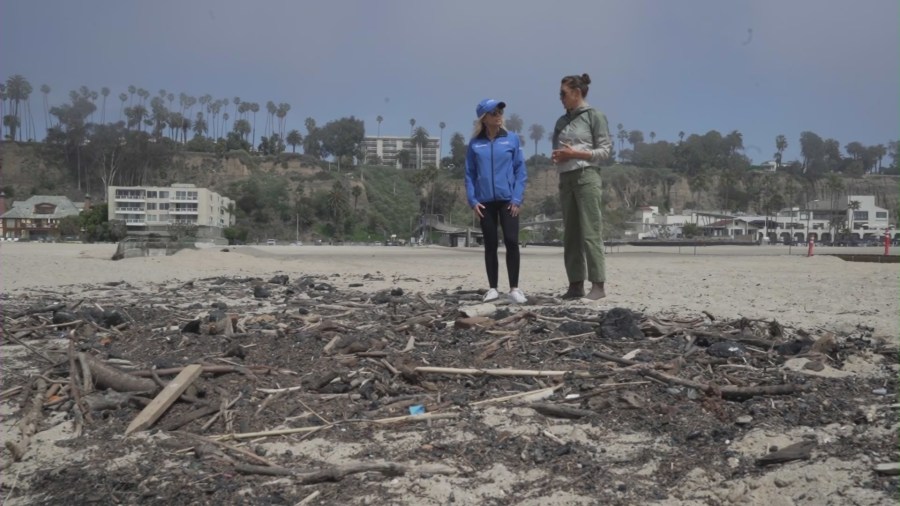As summer approaches and beachgoers flock to the coast, environmental groups are warning that the sand at many of Los Angeles’ most popular beaches may not be safe.
After the Palisades Fire burned more than 23,000 acres in January, toxic debris has blanketed several coastal communities. Now, environmental organizations say the sand contains harmful toxins.
It’s been four months since the fire, and chunks of toxic debris remain in storm drains — not just pieces of homes, but electronics, car parts and other unknown materials. Concerned for public safety, one local conservationist, who is also a mother, spent $8,000 of her own money to test sand from multiple locations in Santa Monica Bay.
Ashley Oleson, a conservation biologist who spends time at the beach daily, said the debris has been polluting the beaches and storm drains for months, creating a public health hazard.
“It’s shocking. I know it’s hard to believe that kids play here all the time. I see kids in this water,” Oleson said.
She confirmed the presence of toxic metals.
“This is, yeah, I tested this specifically. And lead, arsenic, mercury and chromium,” she said.
Concerned about the impact on wildlife and the environment, Oleson has been tracking the response to the debris and repeatedly speaking at Santa Monica City Council meetings to urge officials to stop grooming the sand.
“As this debris has been left out on the beach in the sun, it’s become really brittle. It’s breaking into smaller and smaller pieces,” Oleson said. “They groom the beach and they — and it’s just a big rake. And so as they’re doing this now, all the pieces of debris that are brittle, you’ll see they’re burnt, pieces of wood are breaking down and being spread all over.”
Oleson began collecting sand samples 49 days before government agencies conducted their own testing. She sent six critical samples from January and February to a lab and compared the data to California Human Health Screening Levels.

Her results showed that arsenic, chromium and mercury were above safe levels and rose even more after two rain events. Lead levels were below the screening threshold, but she said no amount of lead is safe for children.
“I absolutely don’t think it’s safe for children, especially with the hand-mouth behavior on the sand,” Oleson said.
The State Water Board conducted its own testing in late February, collecting 15 samples across Santa Monica Bay, from Zuma Beach to RAT Beach. Arsenic levels were above the state’s safe thresholds at all 15 locations. Lead was present at all sites as well.
However, Los Angeles County health officials said those lead levels were below background levels and do not pose a risk to human health.
In a statement, officials said: “Beachgoers may now enter the ocean water and recreate on the sand in these areas, but they are still advised to avoid fire debris in the water, as the fire debris may contain harmful substances.”
Jane Williams, executive director of California Communities Against Toxics, said she wouldn’t let her own children near the affected sand.
“I wouldn’t want my children playing in that sand. I wouldn’t want that sand in my sandbox,” Williams said.

She argued the metrics being used by the county are outdated, especially after the Environmental Protection Agency tightened decades-old standards on lead dust exposure in January.
“Well, the most current EPA standards on indoor lead exposure is zero. And the most current Center for Disease Control guidance document on lead exposure is zero,” Williams said.
She also noted that arsenic, like lead, is more dangerous than previously thought.
“Arsenic is similar to lead, except it’s carcinogenic as well as being a neurotoxin,” she said. “And so this is something that the state probably should rethink and develop new guidance on.”
Both Williams and Oleson said officials need to communicate better with the public by posting warning signs on the beach to alert visitors about elevated toxic metal levels.
“I’m still looking at so much debris, which could be manually removed from here that kids are playing in daily,” Oleson said. “And so I don’t understand how that is acceptable at this point. The homes that burned down in Malibu are still sitting in the water’s edge right now, leaching all kinds of stuff into the ocean which comes directly here onto our shores. The bottom line is do you want your family to be exposed to these — this number of lead or mercury or arsenic? I think that overall people are going to say no.”
Los Angeles County health officials declined to speak on camera. The city of Santa Monica did not respond to requests for comment.
Officials have never tested Santa Monica Bay beaches for toxic metals before, meaning there are no benchmarks to compare current results against. They used results from previous California wildfires instead — but some experts say that’s not an accurate comparison, noting that an urban wildfire like the Palisades Fire reaching these beaches is unprecedented.
The most recent testing showed arsenic levels above what the state considers safe. While officials claim these are within naturally occurring levels, experts dispute that.
Exposure to these toxins likely won’t cause immediate symptoms but may increase the risk of long-term health problems.
County officials said they plan to test again before Memorial Day.
